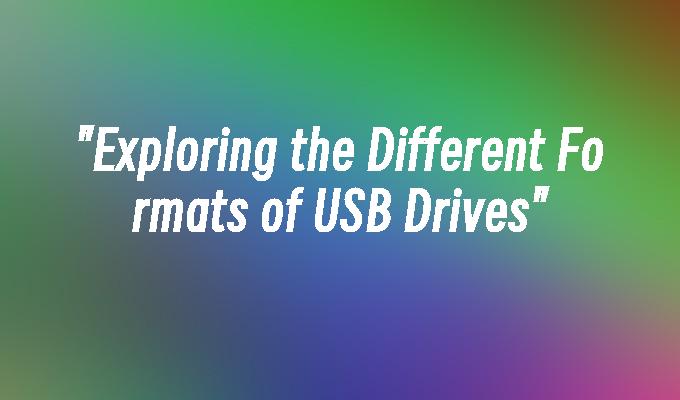Exploring the Different Formats of USB Drives
- 时间:2023年08月30日 17:56:05 来源:魔法猪系统重装大师官网 人气:15965
Introduction:
USB drives, also known as flash drives or thumb drives, have become an essential tool for data storage and transfer. In this article, we will explore the different formats of USB drives, discussing their advantages, limitations, and compatibility. By understanding the various formats available, users can make informed decisions when choosing a USB drive that suits their needs.
Tools and Materials:
Computer: Dell XPS 15, MacBook Pro
Operating System: Windows 10, macOS Catalina
Software: USB Disk Storage Format Tool, Disk Utility
1. USB 2.0 vs. USB 3.0
1.1 USB 2.0: This format, widely used in older devices, offers slower data transfer speeds compared to USB 3.0. It is compatible with most computers and devices, making it a reliable choice for basic file storage and transfer.
1.2 USB 3.0: With faster data transfer rates, USB 3.0 is ideal for large file transfers and high-definition media. It is backward compatible with USB 2.0, ensuring compatibility with older devices. However, to fully utilize the speed of USB 3.0, both the USB drive and the device it is connected to must support this format.
2. FAT32 vs. exFAT vs. NTFS
2.1 FAT32: This format is compatible with both Windows and macOS systems, making it a versatile choice. However, it has a file size limitation of 4GB, which can be a drawback when dealing with large files.
2.2 exFAT: Developed by Microsoft, exFAT offers improved compatibility and supports larger file sizes compared to FAT32. It is suitable for cross-platform usage and is commonly used in USB drives.
2.3 NTFS: This format is primarily used in Windows systems and supports advanced features such as file encryption and compression. However, it has limited compatibility with macOS and some other devices.
3. Partitioning and Bootable USB Drives
3.1 Partitioning: USB drives can be partitioned into multiple sections, allowing users to organize their data efficiently. This is particularly useful when using a USB drive for both personal and work-related files.
3.2 Bootable USB Drives: By creating a bootable USB drive, users can install or repair operating systems on their computers. This is a handy tool for system administrators and individuals who frequently troubleshoot computer issues.
Conclusion:
In conclusion, USB drives come in various formats, each with its own advantages and limitations. USB 3.0 offers faster data transfer speeds, while USB 2.0 ensures compatibility with older devices. FAT32, exFAT, and NTFS provide different levels of compatibility and file size support. Additionally, partitioning and creating bootable USB drives enhance the versatility and functionality of these storage devices. By understanding the different formats and their applications, users can make informed decisions when selecting a USB drive for their specific needs.









